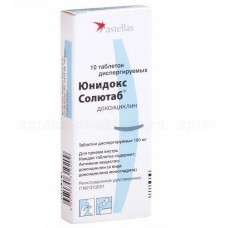Expiration date: 06/2029
Form release
The pills are dispersible.
Packaging
10 or 20 PCs.
Pharmacological action
Broad-spectrum antibiotic from the tetracycline group. The drug action is bacteriostatic, inhibits protein synthesis in the microbial cell by interaction with 30S ribosome subunit. Active against many gram-positive and gram-negative microorganisms: Streptococcus spp., Treponema spp., Staphylococcus spp., Klebsiella spp., Enterobacter spp. (including E. aerugenes), Neisseria gonorrhoeae, Neisseria meningitidis, Haemophilus influenzae, Chlamydia spp., Mycoplasma spp., Ureaplasma urealyticum, Listeria monocytogenes, Rickettsia spp., Typhus exanthematicus, Escherichia coli, Shigella spp., Campylobacter fetus, Vibrio cholerae, Yersinia spp. (including Yersinia pestis), Brucella spp., Francisella tularensis, Bacillus anthracis, Bartonella bacilliformis, Pasteurella multocida, Borrelia recurrentis, Clostridium spp. (except Clostridium difficile), Actinomyces spp., Fusobacterium fusiforme, Calymmatobacterium granulomatosis, Propionibacterium acnes, some simple (Entamoeba spp., Plasmodium falciparum).
As a rule, has no effect on Acinetobacter spp., Proteus spp., Pseudomonas spp., Serratia spp., Providencia spp., Enterococcus spp.
One should take into account the possibility of acquired resistance to doxycycline in a number of pathogens, which is often cross-group (i.e. strains resistant to doxycycline, at the same time will be resistant to the whole group of tetracyclines).
Indications
Infectious and inflammatory diseases caused by microorganisms sensitive to the drug:
- respiratory tract infections (including pharyngitis, acute bronchitis, exacerbation of chronic obstructive pulmonary disease, tracheitis, bronchopneumonia, shared pneumonia, community-acquired pneumonia, lung abscess, pleura empyema);
- infections of ENT organs (including otitis media, sinusitis, tonsillitis);
- infections of the genitourinary system (cystitis, pyelonephritis, bacterial prostatitis, urethritis, urethrocystitis, urogenital mycoplasmosis, acute orhiepididimit; endometritis, and endocervicitis salpingoophoritis /in combination therapy/);
- infection, sexually transmitted infections (urogenital chlamydia, syphilis patients with intolerance to penicillins, uncomplicated gonorrhea /as an alternative therapy/, inguinal granuloma, lymphogranuloma venereum);
- infections of the gastrointestinal tract and biliary tract (cholera, yersiniosis, cholecystitis, cholangitis, gastroenterocolitis, bacillary and amoebic dysentery, diarrhea travelers);
- skin and soft tissue infections (including wound infections after animal bite), severe acne (as part of combination therapy);
- other diseases: yaws, legionellosis, chlamydia various localization (including prostatitis and proctitis), rickettsiosis, fever, Rocky mountain spotted fever, typhoid (including typhus, tick), Lyme disease (stage I) - erythema migrans, tularemia, plague, actinomycosis, malaria, leptospirosis, psittacosis, ornithosis, anthrax (including pulmonary form), bartonellosis, granulocytic erlihioz, whooping cough, brucellosis;
- infectious diseases of the eye (as part of combination therapy) - trachoma;
- osteomyelitis;
- sepsis;
- subacute septic endocarditis;
- peritonitis.
Prevention of postoperative purulent complications and malaria caused by Plasmodium falciparum during short-term travel (less than 4 months) in areas where chloroquine and/or pyrimethamine-sulfadoxine resistant strains are common.
Contraindications
- severe hepatic and/or renal impairment;
- porphyria;
- pregnancy;
- lactation (breastfeeding));
- children up to 8 years old;
- hypersensitivity to antibiotics of tetracycline group.
Application for pregnancy and breastfeeding
Doxycycline penetrates through the blood-placental barrier. Tetracyclines have an adverse effect on the fetus (slowing osteogenesis) and the formation of tooth enamel (irreversible change in color, hypoplasia). In view of this, as well as the increased risk of liver damage in the mother, tetracyclines are not used during pregnancy, except when the drug is the only means to treat or prevent particularly dangerous and severe infections (spotted fever rocky mountains, inhalation exposure Bacillus anthracis and others).
Prior to the designation of doxycycline women of childbearing age, you should exclude the presence of pregnancy.
Doxycycline penetrates into breast milk. Due to the adverse effects on the fetus, doxycycline, like other tetracyclines, are not used during breastfeeding. If the appointment of tetracyclines is necessary, breastfeeding should be discontinued.
Special instruction
There is a possibility of cross-resistance and hypersensitivity to other tetracycline drugs.
Tetracyclines can increase prothrombin time, the appointment of tetracyclines in patients with coagulopathy should be carefully monitored.
The antianabolic effect of tetracyclines can lead to an increase in the level of residual urea nitrogen in the blood. As a rule, it is not essential for patients with normal renal function. However, in patients with renal insufficiency may be observed increase in nitrogen. The use of tetracyclines in patients with impaired renal function requires medical control.
With prolonged use of the drug requires periodic monitoring of laboratory parameters of blood, liver and kidney function.
Due to the possible development of photodermatitis it is necessary to limit the insolation during treatment and within 4-5 days after it.
When using the drug, both on the background of the reception, and 2-3 weeks after discontinuation of treatment may develop diarrhea caused by Clostridium dificile. In mild cases, it is enough to cancel the treatment and use of ion-exchange resins (colestiramine, colestipol), in severe cases, compensation for loss of fluid, electrolytes and protein,
the appointment of vancomycin or metronidazole.
Do not use drugs that inhibit intestinal motility.
Prolonged use of the drug can cause dysbiosis and, consequently, the development of hypovitaminosis (especially vitamins b).
To prevent dyspeptic phenomena, it is recommended to take the drug during meals.
In order to avoid the development of esophagitis or esophageal ulcers, it is necessary to take a drug with a large amount of water and avoid using the drug immediately before going to bed.
Influence on the ability to drive vehicles and management mechanisms
The influence on the ability to drive vehicles, machines and mechanisms is unknown. In the case of dizziness, blurred vision or double vision, driving vehicles or machinery is not recommended.
Composition
Doxycycline monohydrate, equivalent to doxycycline 100mg.
Auxiliary substances: microcrystalline cellulose - 45 mg, saccharin - 10 mg, hyprolose (low-substituted) - 18.75 mg, hypromellose-3.75 mg, silicon colloidal dioxide (anhydrous) - 0.625 mg, magnesium stearate-2 mg, lactose monohydrate-up to 250 mg.
Method of application and doses
Tablets disperse (dissolve) in a small amount of water (about 20 ml) to obtain a suspension. Tablets can also be swallowed whole, divided into parts or chewed, drinking water.
The drug is preferably taken with meals. Take tablets sitting or standing, which reduces the likelihood of esophagitis and esophageal ulcer. The drug should not be taken immediately before bedtime.
Usually the duration of treatment is 5-10 days.
Adults and children over 8 years weighing more than 50 kg on the first day of treatment appoint 200 mg/day in 1 or 2 admission, in the following days of treatment - 100 mg/day in 1 admission. In the case of severe infections, 200 mg/day is prescribed for the entire period of treatment.
For children aged 8-12 years with a body weight of less than 50 kg, the average daily dose is 4 mg/kg on the first day, then - 2 mg/kg / day (1-2 admission). In cases of severe infections, the drug is prescribed at a dose of 4 mg / kg daily throughout the treatment.
In case of infection caused by Streptococcus pyogenes, the duration of treatment is not less than 10 days.
In uncomplicated gonorrhea (except for anorectal infections in men) adults are prescribed 100 mg 2 times/day until complete recovery (on average for 7 days), or within one day appoint 600 mg - 300 mg 2 admission (the second reception 1 h after the first).
In primary syphilis appoint 100 mg 2 times/day for 14 days, in secondary syphilis - 100 mg 2 times / day for 28 days.
In uncomplicated urogenital infections caused by Chlamydia trachomatis, cervicitis, negonokokkovom urethritis caused by Ureaplasma urealiticum, appoint 100 mg 2 times/day for 7 days.
When acne is prescribed 100 mg/day, course of treatment is 6-12 weeks.
To prevent malaria, appoint 100 mg 1 time/day 1-2 days before the trip, then - every day during the trip and for 4 weeks after return; children over 8 years - 2 mg/kg 1 time / day. The duration of prevention should not exceed 4 months.
For the prevention of diarrhea travelers-200 mg on the first day of the trip in 1 or 2 admission, then - 100 mg 1 time/day during the stay in the region (no more than 3 weeks).
For the treatment of leptospirosis-100 mg 2 times inside / day for 7 days; for the prevention of leptospirosis - 200 mg 1 time/week during the stay in the disadvantaged area and 200 mg - at the end of the trip.
In order to prevent infections with medical abortion appoint 100 mg for 1 hour before and 200 mg after surgery.
The maximum daily dose for adults - up to 300 mg / day or 600 mg / day for 5 days in severe gonococcal infections. For children over 8 years weighing more than 50 kg-up to 200 mg, for children 8-12 years weighing less than 50 kg-4 mg / kg daily during the treatment.
In renal (CC less than 60 ml/min) and/or liver failure, a reduction in the daily dose of doxycycline is required, since it gradually accumulates it in the body (the risk of hepatotoxic action).
Side effect
From the digestive system: anorexia, nausea, vomiting, dysphagia, diarrhea, enterocolitis, pseudomembranous colitis, esophagitis, esophageal ulcer, dark staining of the tongue, liver damage (during prolonged use or in patients with renal or hepatic insufficiency), cholestasis.
Dermatological reactions: photosensitization, macular-papular and erythematous rash, exfoliative dermatitis.
Allergic reactions: urticaria, angioedema, anaphylactic reactions, exacerbation of systemic lupus erythematosus, pericarditis, syndrome similar to serum disease, multiform erythema.
From the hematopoietic system: hemolytic anemia, thrombocytopenia, neutropenia, eosinophilia, decreased prothrombin activity.
On the part of the endocrine system: in patients who received doxycycline for a long time, perhaps reversible dark brown staining of thyroid tissue.
From the Central nervous system: benign increase in intracranial pressure (anorexia, vomiting, headache, swelling of the optic nerve), vestibular disorders (dizziness or instability), blurred vision, double vision.
On the part of the urinary system: an increase in the residual nitrogen of urea (due to the antianabolic effect).
On the part of the musculoskeletal system: doxycycline slows down osteogenesis, violates the normal development of teeth in children (irreversibly changes the color of teeth, enamel hypoplasia develops).
Other: candidiasis (glossitis, stomatitis, proctitis, vaginitis) as manifestations of superinfection.
Drug interaction
Antacids containing aluminum, magnesium, calcium, iron preparations, sodium bicarbonate, magnesium-containing laxatives reduce the absorption of doxycycline, so their use should be separated by a 3-hour interval.
In connection with the suppression of intestinal microflora doxycycline reduces prothrombin index which requires dose adjustment of indirect anticoagulants.
In combination with doxicillin with bactericidal antibiotics that disrupt the synthesis of the cell wall (penicillins, cephalosporins), the effectiveness of the latter is reduced, which should be taken into account in the treatment of meningitis and tonsillopharyngitis caused by Streptococcus pyogenes.
Doxycycline reduces the reliability of contraception and increases the frequency of acyclic bleeding when taking estrogen-containing hormonal contraceptives.
Ethanol, barbiturates, rifampicin, carbamazepine, phenytoin, accelerating the metabolism of doxycycline, reduce its concentration in blood plasma.
The simultaneous use of doxycycline and retinol increases intracranial pressure.
Overdose
Symptoms: increased adverse reactions caused by liver damage-vomiting, fever, jaundice, azotemia, increased transaminase levels, increased prothrombin time.
Treatment: immediately after ingestion of large doses is recommended gastric lavage, drinking plenty of fluids, if necessary - induction of vomiting. Adopt activated carbon and osmotic laxatives. Hemodialysis and peritoneal dialysis is not recommended due to low efficiency.



